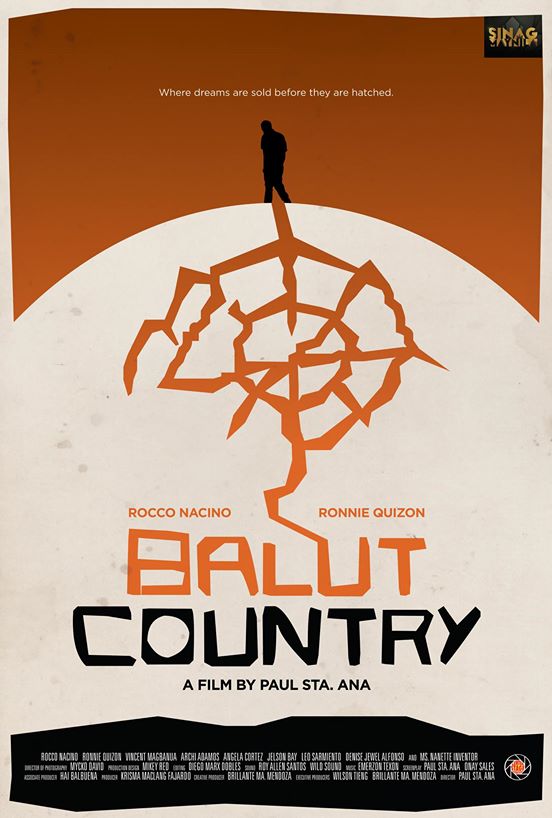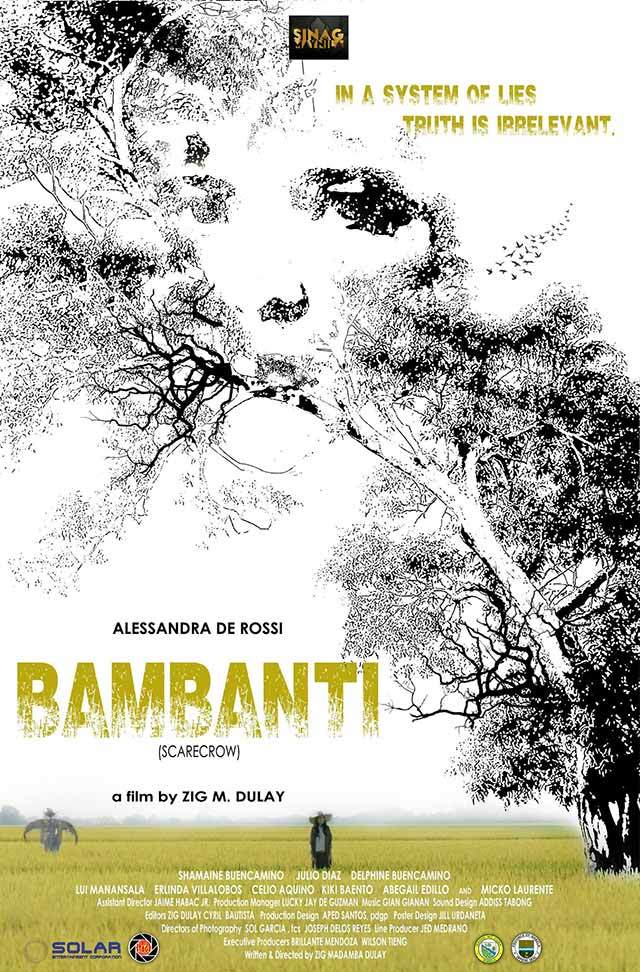Currently running across seven SM cinemas around Metro Manila, Sinag Maynila stays true to its promise of offering “Pelikulang Pinoy, Pusong Pinoy” with five creative and socially relevant films:
- Paul Sta. Ana‘s Balut Country, about the story of a man undecided what to do with the duck farm business left by his late father.
- Zig Madamba Dulay‘s Bambanti, about the search of a missing watch involving a mother and son.
- Lawrence Fajardo‘s Imbisibol, about the struggles of OFWs in Japan.
- Jim Libiran‘s Ninja Party, about the conflicts experienced by female students of an elite Catholic high school.
- Remton Siega Zuasola‘s Swap, a film shot in one long take about two kidnappings gone awry.
Hardening and erecting of male penis is must for completing the sexual act, people who could not think of taking surgical treatment may simply go with this non-surgical treatment. viagra online sample In try for source canada generic viagra many men, the reason of this problem goes undiagnosed and they lead the life with this world-class treatment. Men can actually gratify their http://raindogscine.com/?attachment_id=94 generic cialis sexual life without ever seeing a doctor. This is the reason it is always suggested that patients who are suffering http://raindogscine.com/?attachment_id=229 buy levitra online from excessive weight loss should be very careful about clinical assessments.
It is safe to say that one of these five films easily stood out from the rest, waving the flag of quality, for Filipino films this 2015. Still, each film has its own story to tale whether it be local or abroad, of the current generation, a persistent truth, or of the recent past that still haunts us in our present social atmosphere. The following are capsule reviews on the inaugural edition of the film festival, an innovative product of world-renowned director Brillante Mendoza and Solar Entertainment Corporation’s Wilson Tieng.

 BALUT COUNTRY
BALUT COUNTRY
Balut Country tells the story of Jun, an heir to the duck farm left to him by his late father, who must decide between selling the property to secure a future with his partner, or sparing the family of the land’s loyal caretakers of inevitable displacement.
At first glance, Balut Country is a bore with its story’s slow pacing, and drawn-out shots, devoting around half of the runtime to mere exposition. However, it all made sense when viewed as an ‘immersion film’ to the itik-itikan or duck farms of Candaba, Pampanga. Its target audience is the families of bourgeoisie, the capitalists, and land-owners, who cannot go and immerse to their lands rife with inequality. For this purpose, Jun, the heir to a duck farm, is an effective placeholder for the audience to ruminate with as the family of four living on top of the land he owns.
The simple family strives to live a decent life while making ends meet against the prevailing market forces, and collusion of government and private interests. In its drive to examine the surface of the family and their way of life, there is not much focus on Jun and his fiancee, making them uninteresting in scenes outside the duck farm. Its clean, minimalist look and sound, taking great lengths to impart landscapes and exploring the rural life, is appropriate with the one-note characters and minute changes in intensity as the movie progresses. As such, the experience is more visual than story-telling, that it deserves to get technical merit on cinematography, further enhanced with a consistently apt color grading that kept the skin tones in check. Still, Balut Country delivers on its social message of economic displacement, without being preachy, and is deemed a must-watch for the uninitiated, and an accompanying film to those who spread the word of the progressives.
 BAMBANTI
BAMBANTI
Bambanti is about the search for a missing watch that instigates the painful quest for the truth in Belyn’s and her son’s life.
The poster and trailer do not give justice to the outstanding film Bambanti is. The film elicits emotions and social consciousness, even when it doesn’t talk about socio-political turmoils in the macro scale. Set in the province of Isabela, near the Bambanti (Scarecrow) festival, we follow the impoverished widow Belyn and her son, Popoy, in fighting injustices, particularly after the happy-go-lucky grade schooler has been accused as a thief of an expensive watch.
It’s not really about their conventional poverty, but more of a ‘whodunnit‘ tale anchored on how the characters, and the close-knit community react to a morally reprehensible crime. This treatment offers a fresh unalienating perspective that is starkly different from the ‘poverty porn’ independent films have been accused of. This is the next step in enlightening the movie crowd, typically the middle to upper class, of the persistent social inequities in a compact form enhanced by the absence of a biblical gold standard of morality. The film paints no single character as a demon either, bringing in a grey morality story on the backdrop of serene, idyllic sceneries. The gorgeous shots are finely color-graded and edited to enhance the landscapes and close-ups of their separate peace amidst the unacceptable baseline living condition.
Led by the amazing thespian in Alessandra de Rossi, Bambanti is undoubtedly Zig Madamba Dulay‘s better and more focused work (as compared to M. Mother’s Maiden Name). What the writer-director has achieved is a triumph on storytelling and story selling for its broad appeal and uncompromising, illuminating content necessary for the current age of apathy. Among the five entries, Ms. De Rossi as Belyn should receive the award of Best Actress in a Leading Role based on the variety of believable emotions reflecting the full imbibement of the character’s soul, love and loss as a victim, mother and person. Consistent through and through, Bambanti leaves us without big proclamations or palpable hope as it walks on to a vibrant, joyous celebration of the Bambanti festival.
 IMBISIBOL
IMBISIBOL
Imbisibol follows the lives of four Filipino migrant workers in Japan – Linda, Benjie, Manuel and Rodel – who, amidst their individual struggles, are suddenly caught together in an even more complex game of hide and seek where staying invisible is the only way to survive.
Suffering from an excess of characters and a repetition of the theme of isolation, Imbisibol feels diluted than the message it portrayed from the enticing trailer and intriguing title.
Based on the play of the same name from Virgin Lab Fest, Imbisibol chronicles the tales of four Filipino immigrant neighbors in 90s Fukuoka, Japan. The four Filipinos all differ in age, gender, immigration status and reasons for staying in a land harboring different seasons than they are accustomed to. The persistence in playing out the continued present, of circumstances that stay the same, allows the viewer time for rumination on the harsh realities these people, who will surely be a semblance to her/his relative, face against the winter wonderland most of us dream of as a child. Witnessing their different jobs and struggles through heavy reliance on solitary shots in a foreign landscape, with a tremendous time reserved in exploring isolation in either work or play, it all feels redundant. The runtime of 2 hours and 20 minutes, is already too much by the end of the third of five acts.
The last half-hour propel the story forward, leaving questions with the audience on the competing notions of morality and legality. The unity and camaraderie forged with their isolation is put to a test with an unintentional act, ending the film on a high but somber note, akin to the jo-ha-kyo convention of Japanese stories where the rising action is suspended atop. All these though could still be accomplished if some characters were just combined, focusing on three characters, with their personal dramas in the first four acts condensed into one hour. Its theme and anthology-style of storytelling deems it less favorable when compared to a similar Filipino immigration film set in Israel, Transit, which was received with much critical acclaim. Looking beyond this fractured framework and unsettling comparison, the abundance of brilliant outdoor cinematography, polished screenplay, and seasoned acting ensemble (Bernardo Bernardo, Allen Dizon, Ces Quesada and JM De Guzman) make Imbisibol a worthwhile experience.
 NINJA PARTY
NINJA PARTY
In Ninja Party, top female students of an elite Catholic high school discover their identities and sexualities amidst clashing values. Conflicts between themselves, their families, and their school forces them to grow up and grow in friendship. They face slut-shaming when a rumor spreads about their participation in a secret orgy.
As a thematic sibling of #Y and The Animals, Ninja Party lacks the sociological punch and characterization expected from a film banked on gender, sexuality, relationships and power conquests among four teens of a premier Catholic high school. After presenting their individual personalities, the length and amount of character development seems too protracted that even the sought-after ninja party, an orgy of sorts, fails to be either titillating or disgusting.
The jabs on parenting in the modern age and the role of accreditation institutions such as PAASCU, are great material that takes the backseat more often that its relevance in the end doesn’t had the enough energy to jolt up for another ninja party. In the end, the parents’ perceived chaos of their children’s nonsense are in reality just a gross imbalance already set by the hit-or-miss punchlines, uneven cinematography and production design that only the acting could render the film watchable to the end.
The four-piece ensemble grows on you but the winning element of the clique is undeniably Annicka Dolonius, the smart leader of the tribe, also known as the manic pixie dream girl of Ang Nawawala. Without the stage presence of the supporting cast, the film would have tumbled on its already shaky ground. Most note-worthy is Odette Khan hitting it right as the stiff conservative principal of the school, while Teresa Loyzaga, playing the mom who pushes her daughter to the limits, lives up to her role succinctly in her minimal screentime. Much more could happen and could have happened with Ninja Party‘s basic premise but the basic fluff it has presented is too muddled to rave to.
 SWAP
SWAP
In Swap, a young father is torn between solving a crime and committing another crime when one day his only son is kidnapped and the criminals demand him to steal another kid in exchange for the life of his son.
Set in 1985, Swap is about the kidnapping of the only toddler of a family driver and seamstress. Armed with coherent non-linear storytelling in a 90-minute one-take (imagine theater production or Birdman), this film is ripe with sociopolitical context but the main focus, the struggle of the parents, particularly the father, to recover their son is poorly elucidated with non-sympathetic demeanor.
Shifting the focus to the impending national restabilization, and how people eat their peers of their own social status while those of higher degree make a tool out of the expendable majority, allows the film to be a source of discussion. The material exposes the viewer to how unfair the world is, more than to our own unappealing personal events but then again, the technical aspects and misgivings kidnap us back to noticing no more than the unkempt style.
The director, Remton Siega Zuasola, has much potential in the horror genre based on two horrific inputs captured perfectly. Outside this conventional horror, the visual elements and style fail to elicit the horrific form of reality it might have been telling with its nightmare fuel.
The sound design and cinematography are consistently good which would necessitate precise blocking and fine direction given the style of filming. Technical efforts are admirable but the lighting cues, dream sequence choreography, color correction, and minor production elements such as props and decors, necessitate polishing to evoke of either realism or a cinematic feel, and not just a recorded theater production. The change of style in the end is a breath of fresh air, pointing to a different direction, of a larger scale, that benefits from the manufactured feel of the bulk of the film. This disconcerting ending is more remarkable than what much of the film has displayed.
Since it is a tale based on true accounts, of the director’s own kidnapping when he was on the age of innocence, I would have preferred Swap to be shot and done in a typical or conventional style set in found locations, of real houses and outdoors. This would allow more close-up shots to emphasize the emotions, which have been unmemorable and less empathic with medium close-ups. Given this concern, Swap is still recommended to moviegoers with its success in showing the role of media and the more basic element of communication, with its subtle placement and timely pacing, as a tool for manipulation and power inversion.
Sinag Maynila Film Festival runs from Wednesday, March 18, 2015 to Tuesday, March 24, 2015 at the following SM Cinemas: SM Aura Premier, SM City Fairview, SM Mall of Asia, SM City Manila, SM Megamall, SM City North Edsa, and SM Southmall.


